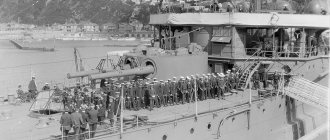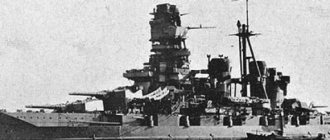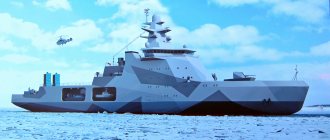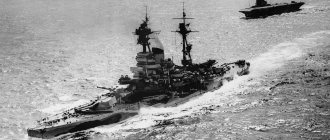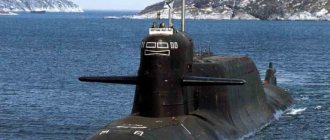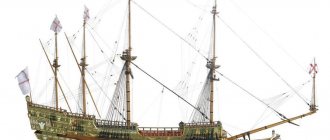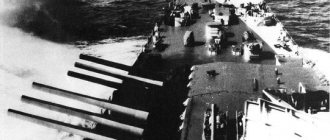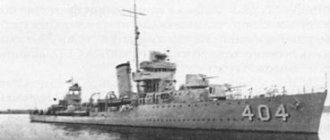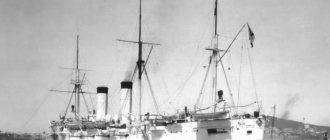Since ancient times, in order to cause damage to enemy merchant shipping, as well as for reconnaissance, ships were equipped that were capable of so-called cruising operations - independent raids on the enemy’s sea and ocean communications.
Russian mine cruiser "Abrek", designed to combat enemy destroyers
During the American Civil War, 19 southern steam ships carried out successful military operations, destroying more than 250 northern ships. True, they were not yet called cruisers. The Alabama steamship was especially distinguished, capturing 68 enemy ships in 2 years. This small ship with a displacement of 1000 tons had solid armament: one 178 mm gun, six 164 mm guns on the sides and one stern rotating 203 mm gun. This artillery was fully involved in the battle with the northerners’ cruiser Kerserge, whose armament included two 280-mm guns. It was they who decided the outcome of the battle, breaking through the Alabama's hull below the waterline.
Just a few years later, in 1868, the first ship of the new class, the steam cruiser Enconstant, entered the English fleet. The armament consisted of ten 229 mm and six 178 mm smoothbore muzzle-loading guns, which by that time were very outdated.
The first Russian cruiser - the armored ship "Admiral General"
The first cruisers were armed with deck guns on pedestal carriages for close combat
The next generation of ships received guns with a rifled bore, loaded from the breech. It was these guns that became the basis of the power of the British Linder-class cruisers with a displacement of 4,300 tons, built in the late 1880s. Steam power plant with a capacity of 5500 hp. With. provided a speed of up to 17.5 knots. The armament consisted of ten 152-mm rifled guns and 16 rapid-fire canisters. There were also 4 torpedo tubes. The armored deck reliably protected the power plant.
Sea communications are rear routes along which the military fleet is supplied from convenient bases and ports.
A communications raid is an external operation aimed at disrupting enemy supply routes.
The first Russian cruisers were the ships “Prince Pozharsky”, “Minin”, “Admiral General” and “Duke of Edinburgh” with a displacement of 4600 tons each. They were laid down in 1870 as armored corvettes, after construction they were assigned to the class of armored frigates, and from February 1, 1892 they were transferred to the class of 1st rank cruisers.
The cruiser Alabama sinks, hit by the guns of the cruiser Kearserge
Along with cruisers of the 1st and 2nd ranks, mine cruisers also appeared in the Russian and other fleets - high-speed light ships intended for reconnaissance and combating enemy destroyers. Built in England by order of the Russian naval department, the 650-ton mine cruiser Abrek had a speed of up to 21 knots and was armed with two 75-mm and four 47-mm cannons, as well as two torpedo tubes.
Battle between the cruiser Kearserge and the armed steamer Alabama
To replenish the fleet with ships capable of conducting cruising operations, the Russian naval department built transport steamships of the Volunteer Fleet, on which fortifications for guns were made in advance. Artillery weapons, quick-assembled powder magazines, and complete sets of ammunition were prepared for them. Such a ship could be retrained as a cruiser in a matter of days.
This experience was fully used by the command of the German fleet during the Second World War, sending several auxiliary cruisers to the Atlantic, converted from specially built transport ships.
The British cruiser Linder had an armored deck
British sailors on the deck of a cruiser with a 4-barrel Nordenfeld 25 mm canister.
The American cruiser Kerserge, armed with powerful 280 mm guns.
"Golden Age" of cruisers
By the beginning of the Russo-Japanese War, cruisers were in the fleets of almost all naval powers in the world. The naval battles of this conflict became a strong argument in favor of the concept of a battlecruiser - a fast ship, only slightly inferior to a battleship in terms of armament and armor. It was believed that such cruisers would be able to take part in battleship battles.
American heavy cruisers of the Northampton project in the battle against Japanese aircraft
The Scharnhorst-class ships were the most powerful armored cruisers in Germany during the First World War. The total displacement of these giants was 12,780 tons. They were armed with 8 guns of an impressive caliber - 210 mm, plus 6 guns of 150 mm caliber, 18 guns of 88 mm caliber and 4 single-tube 450 mm torpedo tubes.
By the beginning of the First World War, all fleets had 27 battle cruisers, the number of 1st and 2nd rank cruisers reached 200 units, and more than 50 such ships were under construction.
However, the concept of battlecruisers in this war as a whole did not justify itself. In the Battle of Jutland in 1916, 3 British and 1 German battle cruiser were killed. These ships had no “arguments” against battleships. At the same time, smaller cruisers of the 1st and 2nd ranks acted quite effectively, and the Russian 1st rank cruiser Aurora even went down in world history as the ship that gave the signal for the beginning of the revolution in Russia.
Russian cruiser "Aurora"
German cruiser "Scharnhorst" during the First World War
The experience of the war was taken into account when developing post-war ships. Battlecruisers disappeared as a class. In Japan, all 4 existing ships of this class were converted into battleships, and unfinished ships were completed as aircraft carriers. They did the same in England.
Germany lost ships of this class under the terms of the Treaty of Versailles, so by the beginning of World War II, battlecruisers were only part of the British Navy. Their combat careers ended differently: the Hood, built in 1918, exploded on May 24, 1941 during a battle with the German battleship Bismarck, the Repalz was sunk by Japanese aircraft on December 8, 1941, and the sister ship Renown immediately after the war it was scrapped.
The cruiser's artillery in the form of a twin installation could fire, including at aircraft
The main caliber of the Kirov cruiser is three-gun turrets of 180 mm caliber
Open gun mounts were installed on cruisers before the advent of fully enclosed turrets
The development of cruisers of the 1st and 2nd ranks was significantly influenced by the agreements on naval armaments concluded by the naval powers in 1922 in Washington and in 1930 in London. For cruisers, a displacement limit was set at 10,000 tons, and the caliber of the guns should not exceed 203 mm.
The American heavy cruisers of the Northampton project with a displacement of 9050 tons had similar characteristics. The lead cruiser entered service in 1930, after which 2 more cruisers were built - Houston and Louisville. The propulsion system had a power of 107,000 hp. With. The armament consisted of nine 200-mm guns in 3 turrets, as well as eight 130-mm cannons, nine 530-mm torpedo tubes and several dozen anti-aircraft guns.
Typical light cruisers of that time were 6 Soviet cruisers of projects 26 and 26 bis. Built in 1938 according to Project 26, the Kirov cruiser was distinguished by its strong armament: nine 180 mm and six 100 mm guns, 16 anti-aircraft guns and 2 three-tube torpedo tubes. Power plant with a capacity of 113,000 liters. With. provided a speed of up to 35 knots.
Soviet cruiser "Kirov"
In the naval battles of World War II, heavy and light cruisers usually operated as part of naval formations, escorted convoys of transport and landing ships, and carried out
general information
The development of the navy began during the times of the Russian Empire. Other countries also tried to keep up in this regard. This is especially true for the USA, France, Germany, Japan and the UK. A cruiser is one of the components of the army, ensuring the sovereignty of the state and its protection from enemy attacks. The flotilla vessels not only provide control of the water border, but also support its land part.
The Navy is entrusted with many tasks. Among them:
- Ensuring the country's security.
- Support for various humanitarian and research campaigns that do not contradict the interests of the state.
- Conducting internal and joint exercises.
Due to this different focus, ships are divided into ranks depending on their main purpose. Vessel classes, in turn, are divided into subcategories. The difference between them lies in the type of power plant, displacement, purpose, and the presence of additional capabilities. In Russia there are four ranks of ships, the highest of which is considered the first. Let's first consider the features, brief characteristics and purpose of cruisers.
Ship "Vasily Bykov"
The types of cruisers in this series are designed to patrol the economic zone, protect the territorial water border, protect against pirate incursions, environmental monitoring, as well as rescue and search for damaged ships. In addition, this cruiser is capable of performing the following tasks:
- Guard and escort merchant or military vessels.
- Perform patrol and rescue mission.
- Used as a means of medical support.
In the next five years, 12 modifications are expected to arrive. This cruiser is a ship that is named after the hero of the USSR, Rear Admiral V. Bykov.
What will be modernized?
It is planned to improve the Admiral Kuznetsov TAVKR. Its Granit launchers will be dismantled, which will increase the area of the aircraft hangar to 4,500 square meters. The armament will be strengthened by anti-aircraft systems using medium-range charges.
Also, ships named after admirals: “Nakhimov”, “Ushakov”, “Lazarev” will undergo modernization. "Peter the Great" is a heavy cruiser, which is also planned to be transformed by 2020. The updates will mainly concern the installation of the latest armed, reconnaissance and radar systems.
In addition, plans for improvement include boats of projects No. 877, 971, 945 (“Halibut”, “Pike”, “Barracuda”, “Condor”). Presumably, they will be equipped with modern anti-aircraft systems and missiles. By and large, these will be universal combat vessels, focused on confronting enemy ground, air and sea forces.
Historical moments
The concept of “cruiser” came into widespread use in the seventeenth century. In those days, this term meant an autonomously operating floating craft. The name was more aimed at defining the purpose of the ship rather than its design. The ships themselves were small, fast and maneuverable. They were used for reconnaissance, information transfer, individual action in protecting territories and military conflicts.
Already in the 18th century, a cruiser was a frigate, which, along with its compact dimensions, had high speed. It houses artillery weapons. Also included in this category are corvettes, brigs, sloops and some other modifications of watercraft.
Interesting Facts
The history of cruisers shows that these ships have been in demand in the navy for several centuries. Modern ships can perform a variety of military tasks, as well as provide significant assistance in eliminating disasters and accidents.
The Russian fleet, despite all the difficulties, remains in a leading position among the navies of the world powers. It is planned to create the latest vessels with the highest characteristics. Many project parameters are kept secret. However, it is known that several modifications are in development. Among them:
- Patrol vessels for distant seas (project No. 11356).
- The newest frigates for the Black Sea.
- Destroyer "Leader".
- Aircraft carrier designed by KGSC IMDS-2013.
All developments are equipped with the latest generation equipment and weapons and can compete on equal terms with the most famous foreign analogues.
Prospects
Design of the advanced aircraft carrier began in 2005. According to plans, the ship was to take its place in the Russian Northern Fleet in 2022. However, during the construction process, conditions and requirements regularly changed, which led to a delay in the process. In 2013, a model presented by the Krylov State Scientific Research Institute was demonstrated.
The designers announced the existence of three projects, the price of each of which, after implementation, will be about 130 billion rubles. The approximate period for the construction of samples is 10 years.
The new ships of the Russian Navy will have the following features:
- Have a displacement of at least 80 thousand tons.
- Equipped with four catapults and a pair of springboards.
- Equipped with several lifts.
- Have the ability to accommodate several amphibious vehicles, as well as attack helicopters.
In addition, it is planned to install on these ships a radar complex similar to the improved analogue of the Mars-Passat, as well as accompanying systems and other types of radars.
Nuclear-powered ships
The nuclear cruiser in the USSR was represented by four units of Project No. 58 (Grozny). They were laid down as destroyers, but in 1977 they were reclassified as missile ships. In addition, between 1970 and 1990, six nuclear-powered icebreakers "Arktika" were developed, most of which remained in the project or were partially converted to other types.
The cruiser "Slava" became one of the ships that received limited mass production. One copy took about four years to build. The new generation of the Soviet fleet is designed for maneuvers in open ocean waters. Their main purpose is to counter strike aircraft carrier commands, amphibious equipment, combat various types of convoys and force support on land and water.
Characteristics of the surface combat ship "Slava":
- length / width / draft – 187 / 19 / 7.5 meters;
- power plant – gas turbine engines;
- the ship is equipped with a platform for placing launchers of the “surface-to-surface” category;
- weapons - surface artillery, anti-submarine torpedoes, anti-aircraft guns and machine guns, the ability to deploy a military helicopter.
